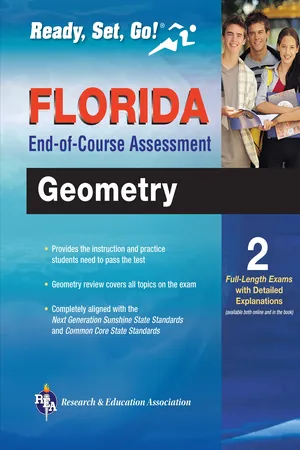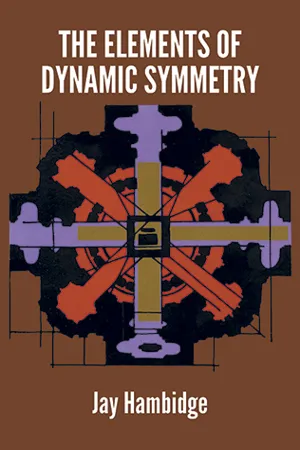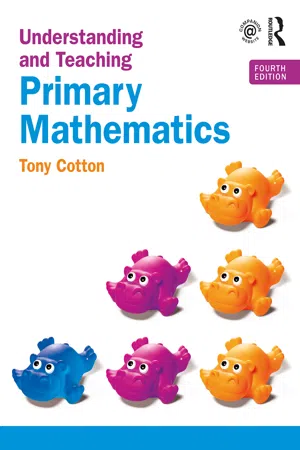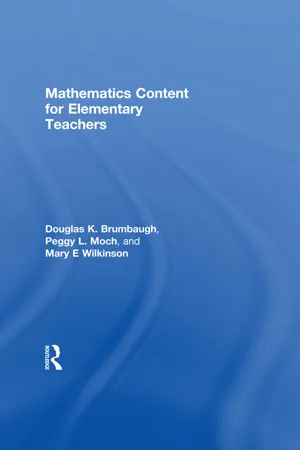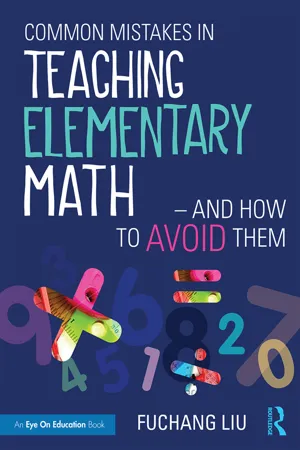Mathematics
Special quadrilaterals
Special quadrilaterals are specific types of four-sided shapes with unique properties. Examples include squares, rectangles, rhombuses, and trapezoids. Each type has distinct characteristics, such as equal sides and right angles for squares, opposite sides of equal length and parallel for rectangles, and opposite sides of equal length and parallel with adjacent sides of equal length for rhombuses.
Written by Perlego with AI-assistance
Related key terms
8 Key excerpts on "Special quadrilaterals"
- eBook - ePub
- Andrew Davis, Maria Goulding, Jennifer Suggate(Authors)
- 2017(Publication Date)
- Routledge(Publisher)
not all equal. So the mathematical version of the term conflicts with ordinary usage.Squares are quadrilaterals with four right angles and equal sides. Hence squares are special kinds of parallelograms and rectangles, and, depending on the precise definition of ‘rhombus’, special kinds of rhombi. ‘Square’ denotes a highly specific class of shapes.‘Oblong ' has no very precise mathematical meaning, but in common speech it refers to rectangles which are not squares.Parallelograms are quadrilaterals where each side is equal in length to the side opposite to it and each side is parallel to the side opposite to it. The characteristic ‘image’ of a parallelogram does not contain right angles. However, rectangles are special kinds of parallelograms. In this respect, the term ‘parallelogram’ is used inclusively, and fortunately the dictionaries seem to concur.Kites are quadrilaterals with two pairs of adjacent equal sides, as in Figure 17.9 . On this definition, squares and rhombi more generally turn out to be special kinds of kites. As before, if we summon up a mental image of a ‘typical’ kite we might want to reject this point. Our rejection is based on faulty ‘shape image’ thinking.Figure 17.9The diagonals of any kite are perpendicular to each other. Examples are shown in Figure 17.10 . Can you prove this?According to the definition of kite, Figure 17.11 is also a kite. How could you show that its ‘diagonals’ intersect at right angles? How exactly is the term ‘diagonal’ being used?Figure 17.10Figure 17.11A rhombus is an equal-sided quadrilateral with opposite sides parallel. (According to this definition, squares belong to this category, though normal usage rarely allows this and some dictionary definitions of ‘rhombus’ suggest the absence of right angles – e.g. the exclusive definition of ‘rhombus’ as ‘parallelogram with sides of equal length but no right angles, diamond-shaped’ features in the Collins GEM English Dictionary. ) Since any rhombus is a kite, the diagonals of any rhombus are perpendicular to each other, as shown in Figure 17.12 - Rebecca Dayton(Author)
- 2013(Publication Date)
- Research & Education Association(Publisher)
Chapter 3Quadrilaterals
Your Goals for Chapter 3
1. You should know the properties of quadrilaterals and use them to solve problems. 2. You should be able to use coordinate geometry to prove the properties and theorems of Special quadrilaterals.Standards
The following standards are assessed on Florida’s Geometry End-of-Course exam either directly or indirectly:MA.912.G.3.1: (Moderate) Describe, classify, and compare relationships among quadrilaterals including the square, rectangle, rhombus, parallelogram, trapezoid, and kite. MA.912.G.3.2: (Moderate) Compare and contrast Special quadrilaterals on the basis of their properties. MA.912.G.3.3: (High) Use coordinate geometry to prove properties of congruent, regular, and similar quadrilaterals. MA.912.G.3.4: (High) Prove theorems involving quadrilaterals. Special quadrilaterals
A quadrilateral is a polygon with four sides. There are several types of Special quadrilaterals.The above figure looks like a tree diagram. It can be thought of as the “Quadrilateral Family Tree” because it shows the relationships among the different types of Special quadrilaterals. Example: True or False. a. A square is a type of rectangle. b. A parallelogram is a type of rhombus. c. A rhombus is a type of kite. d. A parallelogram is a type of trapezoid. e. A rectangle is a type of rhombus. a. True: Although a square does have more specific properties than a rectangle, it does maintain all of the properties of a rectangle. Therefore, a square is a rectangle. b. False: A rhombus must have four congruent sides and a parallelogram does not. Therefore, a parallelogram cannot be a type of rhombus. (However, a rhombus is a type of parallelogram.) c. False: A kite has two separate pairs of congruent adjacent sides rather than the four congruent sides of a rhombus. d. False: A trapezoid can have only one pair of parallel sides. A parallelogram must have two pairs of parallel sides. e. False: A rectangle does not have four congruent sides, therefore, it cannot be a rhombus.- Sandra Rush(Author)
- 2013(Publication Date)
- Research & Education Association(Publisher)
supplementary angles.Rhombus
If we add the condition that all four sides of a parallelogram are equal, then we have a rhombus. So a rhombus has all of the properties of a parallelogram plus the sides are equal.Thus, in the above figure of the rhombus, PQ – QR – RS – SP – s, and the perimeter can be written asLikewise, the area of the rhombus iswhere any of the sides can be used as the base, and the height drawn to each side is the same. The diagonals of a rhombus bisect each other (as they did for the parallelogram), but now they also are perpendicular to each other.Rectangle
If, instead of saying the four sides of the parallelogram are equal, we say that the four angles are equal, we have a rectangle, which is a parallelogram with four equal angles.Thus, in the figure of the rectangle above, and since the angles of a quadrilateral add up to 360°, each of the four angles is 90°, or a right angle.The opposite sides are equal, as in a parallelogram, but not all sides are equal (as they were in the rhombus). The perimeter is written as usual asBecause all the angles are right angles, all sides l (length) are perpendicular to sides w (width), so they take the place of the base and height, and the area of the rectangle isIf we think of tiling a floor in a straight line, we get an idea of why area is length times width. Suppose we wanted to tile a room that is 12 feet by 10 feet in 1-foot tiles. If you count the number of tiles needed, it would be 12 rows of 10 tiles (or 10 rows of 12 tiles), and that total is 120 tiles, each 1 foot square, which is the area of the floor: 120 square feet.- eBook - ePub
- Mel Friedman(Author)
- 2012(Publication Date)
- Research & Education Association(Publisher)
vertex).PARALLELOGRAMSA parallelogram is a quadrilateral whose opposite sides are parallel.Two angles that have their vertices at the endpoints of the same side of a parallelogram are called consecutive angles. So A is consecutive to B; B is consecutive to C; C is consecutive to D; and D is consecutive to A.The perpendicular segment connecting any point of a line containing one side of a parallelogram to the line containing the opposite side of the parallelogram is called the altitude of the parallelogram.A diagonal of a polygon is a line segment joining any two nonconsecutive vertices. The area of a parallelogram is given by the formula A = bh, where b is the base and h is the height drawn perpendicular to that base. Note that the height is the same as the altitude of the parallelogram.Example:The area of the parallelogram below is:A = bhA = (10)(3)A = 30RECTANGLESA rectangle is a parallelogram with right angles.• The diagonals of a rectangle are equal, .• If the diagonals of a parallelogram are equal, the parallelogram is a rectangle.• If a quadrilateral has four right angles, then it is a rectangle.• The area of a rectangle is given by the formula A = lw, where l is the length and w is the width.Example:The area of the rectangle below is:A = lwA = (4)(9)A = 36RHOMBIA rhombus (plural: rhombi) is a parallelogram that has two adjacent sides that are equal.• All sides of a rhombus are equal.• The diagonals of a rhombus are perpendicular bisectors of each other.• The area of a rhombus can be found by the formula where d1 and d2 are the diagonals.ABCD is a rhombus. AC = 4 and BD = 7. The area of the rhombus is - eBook - ePub
- Jay Hambidge(Author)
- 2012(Publication Date)
- Dover Publications(Publisher)
perpendicular; the side opposite the right angle is called the hypotenuse.Any of the angular points of a triangle may be called the vertex. If one of the sides of a triangle has been called the base, the angular point opposite that side is usually called the vertex.A rhombus is a quadrilateral that has all its sides equal.A square is a quadrilateral that has all its sides equal, and all its angles right angles.A parallelogram is a quadrilateral whose opposite sides are parallel.A rectangle is a quadrilateral whose opposite sides are parallel, and whose angles are right angles.A trapezium is a quadrilateral that has two sides parallel.A diagonal of a quadrilateral is a straight line joining any two opposite corners.BOOK II.
Any rectangular parallelogram is said to be contained by the two straight lines containing the right angle.And in any parallelogrammic area let any one whatever of the parallelograms about its diameter with the two complements be called a gnomon. - eBook - ePub
- Tony Cotton(Author)
- 2020(Publication Date)
- Routledge(Publisher)
oblong is a rectangle that isn’t a square. Parallelogram A quadrilateral with opposite sides parallel Trapezium A quadrilateral with only one pair of parallel sides Kite A quadrilateral with adjacent sides (i.e. sides that are joined at a point) of equal lengthPortfolio task 9.3
Try this activity – the folding helps you understand ideas of symmetry, and the surprises when you unfold the shape support you in noticing the properties of the shapes. Children find it motivating too as it develops their skills of visualisation because they have to try to visualise the shape that will emerge when they unfold the paper.Take a piece of A4 paper and make one fold anywhere. You do not have to fold it in half. Make a cut so that you form two shapes out of the piece of paper. Sketch the two shapes that you have made and name them. Can you find ways to fold and cut the paper so that you make a square, a rhombus , a rectangle, a parallelogram , a trapezium and a kite?Three-dimensional shapes can also be classified in several ways.Prismsandpyramidsare sometimes confused. I remember a 14-year-old pupil of mine describing the difference as, ‘A prism is where you find naughty people and a pyramid is where you find dead people’. The actual difference is to do with the cross-section. You can slice a prism at any point, parallel to the face at the end, and you will always get the same cross-section, whereas if you slice a pyramid you will get different sizes of the same shape.Two prisms you might recognise are acubeand a cuboid. The most common 3D shapes are shown as follows. One way of classifying 3D shapes is by the numbers offaces,edgesand vertices (singularvertex - eBook - ePub
- Douglas K. Brumbaugh, Peggy L. Moch, MaryE Wilkinson(Authors)
- 2004(Publication Date)
- Routledge(Publisher)
® and we encourage the use of a dynamic software application as you do this exercise. You may complete the sketches using a straightedge and protractor, but it will be a lot more work. Draw and label polygons with the given characteristics. Name the polygons based on the letters at their vertices, and based on their characteristics. Choose from these terms, using each term only once: acute triangle, equilateral triangle, isosceles triangle, obtuse triangle, parallelogram, quadrilateral, rectangle, rhombus, right triangle, scalene triangle, and trapezoid.a) Three sides with as many right angles as possible. b) Three sides with as many obtuse angles as possible. c) Three sides with as many acute angles as possible. d) Three sides with no sides the same length. e) Three sides with two sides the same length. f) Three sides with all three sides the same length. g) Four sides with no sides the same length. h) Four sides with two opposite sides parallel and the other two opposite sides not parallel. i) Four sides with as many right angles as possible. j) Four sides with all sides the same length and as many obtuse angles as possible. k) Four sides with opposite sides parallel and as many acute angles as possible.In addition to sides and vertices, polygons have other important parts. In Fig. 4.16 , one diagonal of parallelogram DCBA is shown as a dashed segment. The requirements for a quadrilateral to be a parallelogram are that opposite sides are equal in length, denoted as and , and opposite sides are parallel, denoted by and . There are special parallelograms, as shown by the quadrilateral family tree in Fig. 4.14 , but DCBA is a general parallelogram. Trace parallelogram DCBA on a piece of paper and cut it out. Cut along the diagonal from A to C and compare the two polygons you have made.Fig. 4.16.If you repeat this experiment with a few different parallelograms—including rectangles, rhombi, and squares—you can form a conjecture about the relations between parallelograms and triangles. You might trace DCBA again and repeat the experiment using diagonal BD. Although you do not need a formal definition of diagonal of a parallelogram to conduct and understand this experiment, you definitely must know what a diagonal is. - Fuchang Liu(Author)
- 2017(Publication Date)
- Routledge(Publisher)
When the shorter sides of this figure have been increased to the point where they are of the same length with the original longer sides, the measurement is now 10 × 10. This shape doesn’t cease to be a rectangle simply because the two pairs of sides happen to be congruent. In other words, their being congruent doesn’t disqualify such a shape from being a rectangle. No definition of the rectangle ever says that the two pairs of opposite sides must be of different lengths in order to be a rectangle. When they are of the same length, it’s still a rectangle: It’s simply a special rectangle. We call this special rectangle a square.The relationship between rectangles and squares can be illustrated with the diagram in Figure 10.3 .This diagram indicates that the relationship between these two categories is such that one is a subset of the other. They aren’t mutually exclusive of each other. Specifically, all squares are rectangles, but not all rectangles are squares. A squares is just a special kind of rectangle.What’s Wrong with Saying “Triangles, Rectangles, Squares, and Hexagons”?
Although Jane realized that a square is a special rectangle, in practice she often regarded these two shapes, unwittingly, as being two different categories. For example, before presenting geometric solids, Jane wanted her children to review some common 2-D shapes so that when it came to a face on a solid, they could easily recognize that shape. She drew several figures on the board (see Figure 10.4 ) and said, “We have learned different two-dimensional shapes such as triangles, rectangles, squares, and hexagons, and now we are going to move on to three-dimensional shapes.”Figure 10.4 Geometric Shapes That Aren’t Mutually Exclusive of Each OtherThe mistake here is juxtaposing rectangles and squares, and giving children the impression that each type of shape is independent of the other. In fact, this is the root for the common misconception that a rectangle has two longer sides and two shorter sides, as discussed in the previous section.When a list of things is enumerated, each member is usually independent of any other member in the list. In other words, they should be mutually exclusive of each other. You may say to your children, for example, “Please take out a pencil, a marker, and a piece of paper.” But you probably won’t say “Please take out a pencil, a marker, and a red marker”, because a marker and a red marker
Index pages curate the most relevant extracts from our library of academic textbooks. They’ve been created using an in-house natural language model (NLM), each adding context and meaning to key research topics.

